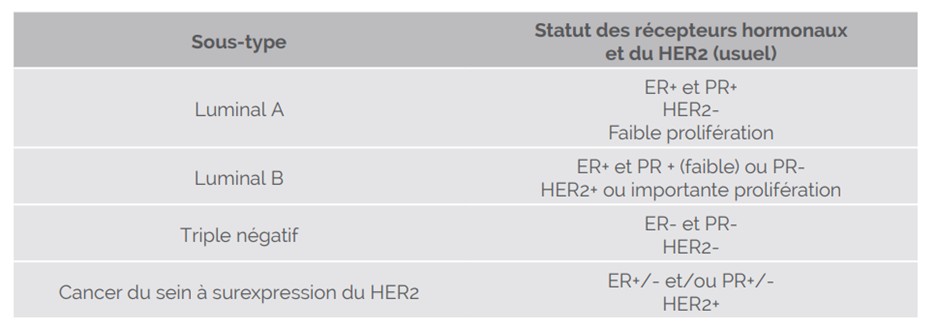By continuing to use our site, you consent to the processing of cookies, user data (location information, type and version of the OS, the type and version of the browser, the type of device and the resolution of its screen, the source of where the user came from, from which site or for what advertisement, language OS and Browser, which pages are opened and to which buttons the user presses, ip-address) for the purpose of site functioning, retargeting and statistical surveys and reviews. If you do not want your data to be processed, please leave the site.
The Voice of People With Breast Cancer
Information
Breast Cancer Basics
Subtypes of Breast Cancer
Breast cancer varies in how it grows and responds to treatment. Some tumours grow quickly, while others develop more slowly. To better understand how a tumour may behave and how to treat it, healthcare teams classify breast cancer based on biomarkers—specific biological features found through lab testing.
The two key biomarkers tested when diagnosing breast cancer are hormone receptor (HR) status, and human epidermal growth factor receptor 2 (HER2) status. Healthcare teams use these, along with tumour stage and grade, to guide treatment decisions. In addition to these biomarkers, breast cancer can be grouped into molecular subtypes.
Note: A person’s subtype can change over time. In 20–30% of cases, the subtype may change if it recurs or spreads.
What Is Hormone Receptor (HR) Status?
Some breast cancer cells have receptors (proteins in or on cells) that attach to the hormones estrogen or progesterone. These hormones can help the cancer cells grow.
Breast cancer cells may have a combination of these receptors:
- Estrogen receptor (ER) positive: Has estrogen receptors
- Progesterone receptor (PR) positive: Has progesterone receptors
- Estrogen receptor (ER) positive, Progesterone receptor (PR) positive: Has both receptors
When breast cancer cells have one or both of these receptors, it is known as hormone receptor (HR) positive. If the breast cancer cells have neither of these receptors, it is known as hormone receptor (HR) negative.
Why Is HR Status Important?
- Blocking these hormones with treatment can slow or stop cancer growth.
- HR positive cancers grow more slowly and respond well to hormone therapy.
- HR negative cancers grow faster, do not respond to hormone therapy, and often require chemotherapy.
- About 75% of breast cancers have at least one hormone receptor, with HR positive cancers being more common in older adults.
What Is HER2 Status?
HER2 is a protein found on breast cells that helps control cell growth. The HER2 gene controls how much HER2 protein a cell makes.
- Normal breast cells have two copies of the HER2 gene and normal HER2 protein levels.
- HER2 positive breast cancer has extra copies of the HER2 gene, leading to extra HER2 protein and uncontrolled growth.
Why Is HER2 Status Important?
-
Doctors test HER2 status on tumour tissue to determine treatment options.
- HER2 postive cancers grow faster than HER2- ones. They respond well to targeted therapies like trastuzumab (Herceptin) and pertuzumab (Perjeta).
- HER2 status can change over time, especially after treatment, recurrence, or metastasis, requiring repeat testing.
Molecular Subtypes of Invasive Breast Cancer
In addition to clinical classifications based on HR and HER2 status, breast cancer can be further divided into molecular subtypes. These subtypes are based on genes and proteins in the cells, helping predict how the cancer may grow and respond to treatment.
The main molecular subtypes include:
- Luminal A (HR positive/HER2 negative): Slow-growing, low levels of Ki-67 (a marker of cell growth)
- Luminal B (HR positive/HER2 positive or HER2 negative): Faster-growing, higher Ki-67 levels
- HER2-Enriched (HER2 positive): HER2 positive, HR negative (ER negative, PR negative)
- Triple-Negative/Basal-Like (TNBC): ER negative, PR negative, and HER2 negative. More common in younger people, Black individuals, and BRCA1 carriers
Why are Molecular Subtypes Important?
Molecular subtypes help predict tumour behavior and guide treatment decisions. While not always included in pathology reports, they are essential in precision medicine and the development of targeted therapies.
Each subtype has distinct characteristics and treatment approaches. The following pages explore these subtypes in more detail and their impact on patient care.
Medical Review by Roochi Arora, MD, FRCPC, August 2025
- References
-
American Cancer Society. (2025). Breast cancer HER2 status. https://www.cancer.org/cancer/types/
breast-cancer/understanding-a-breast-cancer-diagnosis/breast-cancer-her2-status.htmlAmerican Cancer Society. (2021). Breast cancer hormone receptor status. https://www.cancer.org/cancer/types/
breast-cancer/understanding-a-breast-cancer-diagnosis/breast-cancer-hormone-receptor-status.htmlCanadian Breast Cancer Network. (2022). Breast cancer and you: A guide for people living with breast cancer [PDF]. https://cbcn.ca/web/default/files/public/
Reports/Breast%20Cancer%20and%20You_
ENG_edit_web.pdfCanadian Breast Cancer Network. (2014). Know your type [Infographic]. https://cbcn.ca/web/default/files/public/
Reports/Know%20Your%20Type%20
Infographic%20ENGLISH%20(September%
2030%2C%202014).pdfDePolo, J. (2025). Breast cancer hormone receptor status. Breastcancer.org. https://www.breastcancer.org/pathology-report/hormone-receptor-status
DePolo, J. (2024). Molecular subtypes of breast cancer. Breastcancer.org. https://www.breastcancer.org/types/
molecular-subtypesMcAnena, P. F., McGuire, A., Ramli, A., Curran, C., Malone, C., McLaughlin, R., Barry, K., Brown, J. A. L., & Kerin, M. J. (2018). Breast cancer subtype discordance: Impact on post-recurrence survival and potential treatment options. BMC Cancer, 18(1), 203. https://doi.org/10.1186/s12885-018-4101-7
National Cancer Institute. (2024). Cancer stat facts: Female breast cancer subtypes. National Institute of Health. https://seer.cancer.gov/statfacts/html/
breast-subtypes.htmlNolan-Pleckham, M. (2023). The Ki-67 proliferation marker test and breast cancer treatment. Verywell Health. https://www.verywellhealth.com/ki-67-tumor-marker-test-430609
Orrantia-Borunda, E., Anchondo-Nuñez, P., Acuña-Aguilar, L. E., Gómez-Valles, F. O., & Ramírez-Valdespino, C. A. (2022). Subtypes of breast cancer. In H. N. Mayrovitz (Ed.), Breast Cancer (pp. 31-42). Exon Publications.
Susan G. Komen. (2022). Molecular subtypes of breast cancer. https://www.komen.org/breast-cancer/diagnosis/molecular-subtypes/
Yersal, O., & Barutca, S. (2014). Biological subtypes of breast cancer: Prognostic and therapeutic implications. World Journal of Clinical Oncology, 5(3), 412–424. https://doi.org/10.5306/wjco.v5.i3.412
SHARE





